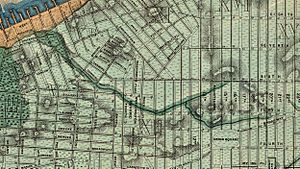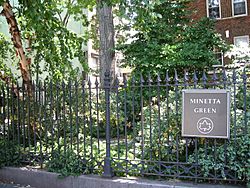Minetta Creek facts for kids

Minetta Creek was once one of the biggest natural streams in Manhattan, New York City. It was fed by two smaller streams, called tributaries. One started near Fifth Avenue and 21st Street, and the other near Sixth Avenue and 16th Street. These two streams met close to Fifth Avenue and 11th Street, then flowed southwest.
The name Minetta Creek might come from a Native American word, "Manette," which meant "Devil's Water." Another idea is that it came from the Dutch word "Minnetje," meaning "the little one." The Dutch originally called it Bestevaer's Killetje. In the 1700s, lots of wild animals lived around the creek. By the mid-1800s, the creek was mostly filled in and covered. However, it continued to flow as an underground stream for many years. Even today, people debate if the creek still exists, as it caused flooding in basements and construction sites for a long time.
Where Minetta Creek Flowed
Minetta Creek was one of Manhattan's largest natural waterways. It was nearly 2 miles (3.2 km) long. The main stream started near Fifth Avenue and 21st Street. A second stream began at Sixth Avenue and 16th Street. These two streams flowed south and joined together between 11th and 12th Streets, near Fifth and Sixth Avenues.
From there, the creek flowed south through what is now Washington Square Park. Then it curved southwest, following the path of present-day Minetta Lane. It also roughly followed Minetta Street, a short road that goes south from Minetta Lane. Finally, Minetta Creek turned west along what is now Downing Street. It eventually emptied into the Hudson River near Charlton Street.
How Minetta Creek Got Its Name
Minetta Creek is also known by other names like Minetta Brook, Minetta Stream, or Minetta Water. Before the American Revolutionary War, it was called Bestevaer's Killetje by the Dutch.
A plaque on a building at Two Fifth Avenue explains one idea for the name "Minetta." It says:
A brook winds its erratic way beneath this site
The Indians called it Manette or Devil's Water To the Dutch settlers it was Bestevaer's Killetje or Grandfather's Little Creek For the past two centuries familiar to this neighborhood as Minetta Brook
Another idea is that "Minetta" comes from the Dutch word "Minnetje." This word means "the little one." It might have been used to tell it apart from a larger creek nearby.
Minetta Creek in Early Days
During the time when the Dutch lived in New York, the area around Minetta Creek was known as the "Land of the Blacks." This land was settled by Africans who had gained their freedom. A path along the creek, called the "Negroes' Causeway," later became part of Minetta Street.
The creek was famous for having lots of fish, especially trout. Other fish like pickerel, bass, and pike were also caught there. Many wild birds, such as ducks and geese, lived around the creek.
In the late 1700s, the British built defenses for the city. They even dammed Minetta Water to create a lake in what is now the West Village. Minetta Creek was an important landmark for people surveying land. Many old documents from the 1600s and 1700s mention the creek by its Dutch name, Bestevaer's Killetje.
A swampy area existed in what is now Washington Square Park. This swamp was fed by the waters of Minetta Creek. The creek also formed a boundary for a potter's field, which was a burial ground used from 1797 to 1825.
The southernmost part of the creek flowed through an estate called Richmond Hill. In 1794, Aaron Burr leased this estate. He changed the creek's path to create a pond called "Burr's Pond" on his property.
Covering the Creek
In 1820, the city council decided to cover Minetta Stream. They hired James Wallace to build a sewer over it. One reason for this sewer was to drain water away from the potter's field. In 1823, the council asked Thomas Cummings to make the creek's riverbed deeper.
As Fifth Avenue was being opened, the council decided in 1824 to put the creek into a culvert (an underground pipe) from Fourth Street (now Washington Square South) to Sixth Street (now Washington Square North). After the potter's field closed in 1825, the area became a military parade ground, which later became Washington Square Park. By 1828, the creek's water was sent to the Hudson River through a wooden sewer.
By 1849, the Richmond Hill estate was torn down and replaced with houses. This showed that water no longer flowed openly through that area. A house built in 1846 at 45 West Twelfth Street has an unusual eastern wall. It slightly overlaps the house next door because it was built right on the bank of Minetta Creek.
In 1892, the New York Times reported that a merchant's cellar was flooding. The newspaper spoke with Egbert Ludovicus Viele, who had created a map of Manhattan in 1865 showing the creek. Viele explained that Minetta Creek was a source of water before the Croton Distributing Reservoir was built in 1842. After the reservoir, the creek was no longer needed for water and became a place for dumping waste. Viele believed the flooding came from the creek's natural springs, which could not be dammed.
In 1894, author Thomas A. Janvier wrote that even though Minetta Creek was no longer visible, it still flowed underground. He warned that buildings near or over it needed strong foundations. He mentioned several recent floodings in buildings along the creek's path. In 1897, George Everett Hill and George E. Waring, Jr. also wrote that deep digging near the creek's path almost always found its waters.
Finding the Creek Underground Today
In the 1900s, construction projects often found Minetta Creek's water underground. In 1900, workers building the Hudson and Manhattan Railroad (now the PATH) had to deal with quicksand caused by the water. In 1901, Egbert Ludovicus Viele was again asked about flooding in a construction project, and he confirmed it was from Minetta Creek.
In 1907, a construction company building the H&M Railroad said the water had dried up. This was good news for property owners who had spent a lot of money on pumps. However, in 1928, when the Independent Subway System built the West Fourth Street–Washington Square station, a reporter saw the stream flowing in the construction site.
In 1929, workers building the Jefferson Market found their site filled with water. The chief engineer said it was from Minetta Creek. A photo from that time shows a pool of water from the creek. In 1977, during construction at Saint Vincent's Catholic Medical Center, workers found Minetta Creek water again. They reported it was "quite clean" and flowed "quite rapidly."
The construction of Jimi Hendrix's Electric Lady Studios in 1968 was delayed partly due to flooding from Minetta Creek. In 2014, an author visited the studios and saw water from the creek "rushing clear and steady" through a hole in the cellar.
Today, people still disagree about whether Minetta Creek truly exists. Some bloggers claim it does, pointing to basement floodings. Others have searched and found no evidence of underground water. In 2012, a local news station reported on people looking into a manhole on Sixth Avenue. They found water that "looked too clean for the city sewer." A historian also noted potholes and basement flooding along the creek's old route.
Gallery
- Examples of Minetta Creek's effect on Manhattan topography
- Places named for Minetta Creek












